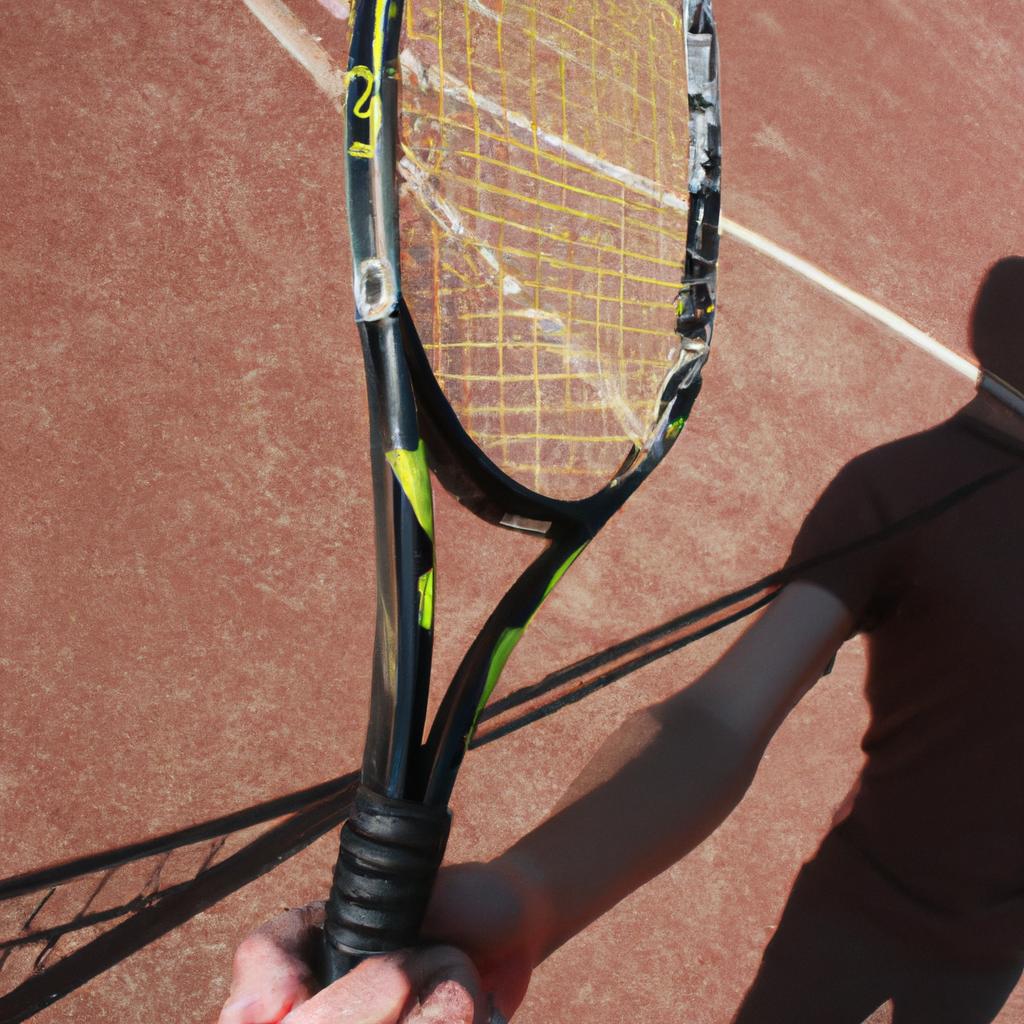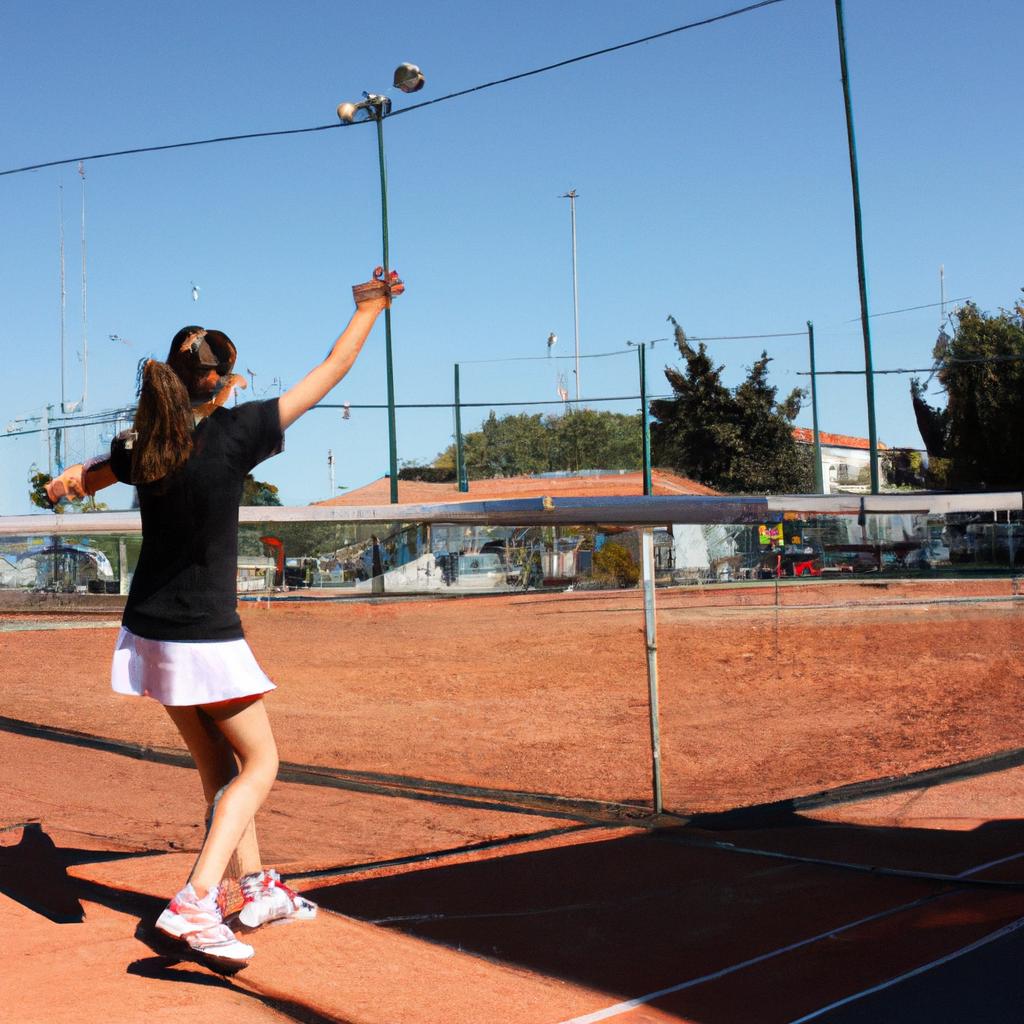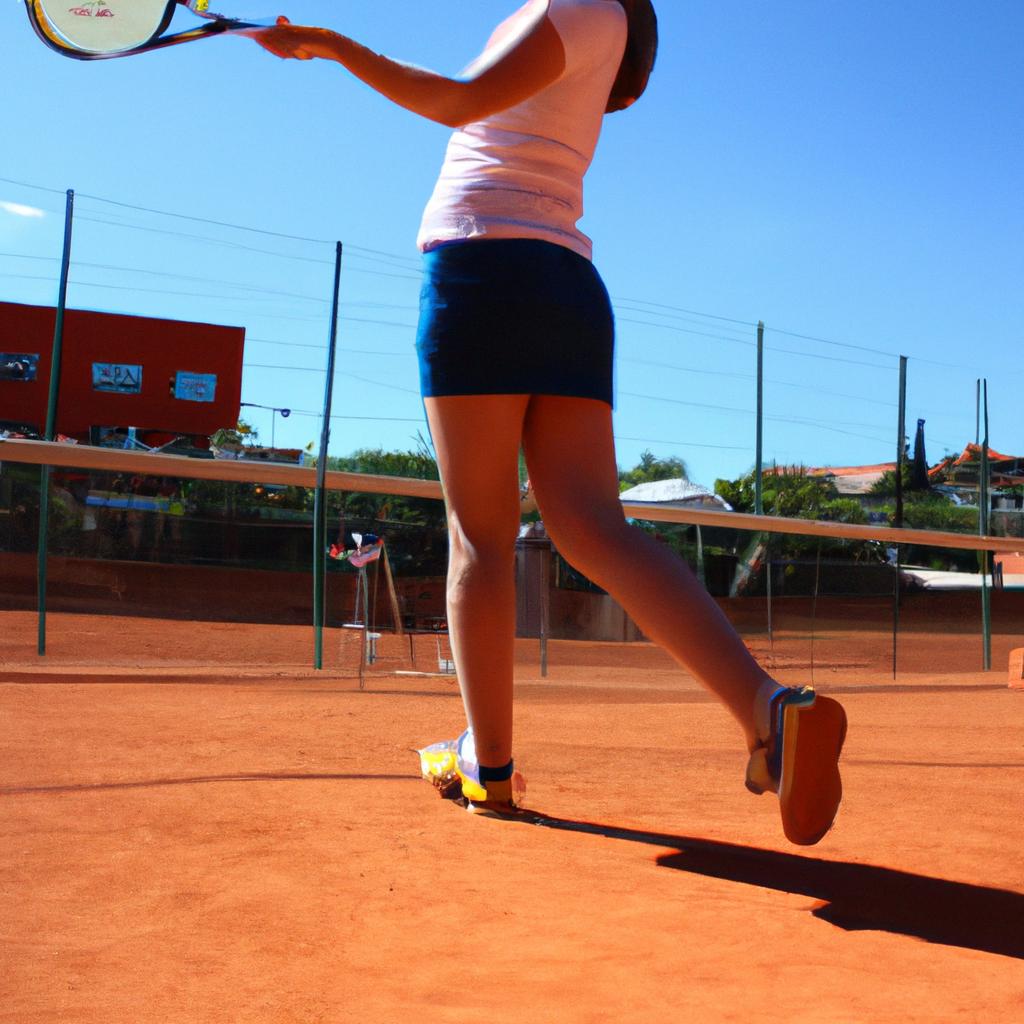Tennis is a popular sport that requires precision, agility, and strategy. Whether you are an aspiring professional or simply enjoy the game as a hobby, understanding the dimensions of a tennis court is crucial for your overall performance. In this article, we will explore the importance of knowing the exact measurements of a tennis court and how it can enhance your gameplay experience.
Imagine yourself participating in a friendly match at your local swim and tennis club. You confidently step onto the court, ready to showcase your skills. However, as soon as you start playing, you notice something feels off – perhaps the boundaries seem too close or far apart. Frustration sets in as you struggle to adapt to unfamiliar surroundings. This scenario highlights why having a comprehensive understanding of tennis court dimensions is essential: it ensures fair play and allows players to develop effective strategies tailored to specific court sizes.
In this guide, we will delve into various aspects of tennis court dimensions, including length, width, net height, service lines, and more. By acquainting ourselves with these precise measurements, both beginners and experienced players can optimize their training sessions and improve their performance on any type of tennis court. So let us now embark on this journey through the intricacies of tennis court dimensions – an indispensable resource for anyone looking to excel in the sport of tennis.
Standard Tennis Court Size
Imagine a group of tennis enthusiasts gathering at their local swim and tennis club, eagerly awaiting their tennis lessons. As they step onto the court, the first thing that catches their attention is its size. A standard tennis court measures 78 feet in length and 36 feet in width. This standardized dimension ensures consistency across various tournaments and matches worldwide.
To further illustrate this point, let’s consider a case study involving a professional tennis match. The athletes are engaged in an intense rally, showcasing their skills and agility on the court. With each powerful stroke, they navigate within the designated dimensions of the playing area, relying on muscle memory developed through years of training.
Understanding the significance of these measurements goes beyond mere statistics; it evokes an emotional response among players and spectators alike. Here are four key aspects to appreciate about standard tennis court size:
- Balance: The symmetrical layout fosters fair play by offering equal opportunities for both competitors.
- Strategy: Within the confined space, players must strategically position themselves to maximize shot angles while anticipating their opponent’s moves.
- Challenge: Limited room for error increases the level of difficulty and demands precision from players.
- Tradition: Embracing tradition, adherence to standard dimensions preserves the integrity of the sport across generations.
In addition to grasping these concepts, we can delve deeper into understanding specific elements related to standard tennis court size through a table outlining its vital components:
| Component | Measurement |
|---|---|
| Overall Dimensions | 78 feet x 36 feet |
| Baseline | 27 feet from net |
| Service Line | 21 feet from baseline |
| Net Height | 3 feet (at center) |
Appreciating why these dimensions matter heightens one’s appreciation for the game of tennis as a carefully crafted interplay between skill, strategy, and athleticism. We will now explore how variations in court dimensions for singles and doubles play add further layers of complexity to the game.
Singles and Doubles Court Dimensions
Having explored the standard dimensions of a tennis court, we now turn our attention to the specific details regarding singles and doubles court dimensions. Understanding these variations is essential for players aiming to compete or improve their skills in either format.
Singles and Doubles Court Dimensions:
Let’s consider an example scenario where two friends, Alex and Sarah, are planning to play a friendly game on their community tennis court. While both enjoy playing singles matches, they also occasionally participate in doubles tournaments. To cater to different preferences and competition formats, it is crucial for them to understand the differences in court dimensions between singles and doubles games.
To provide clarity, here are some key points outlining the variation in court size between singles and doubles:
- Singles courts have narrower widths compared to doubles courts.
- The length of both types of courts remains constant at 78 feet (23.77 meters).
- In singles matches, the width of the court measures 27 feet (8.23 meters), providing ample space for one-on-one play.
- Doubles matches require more room for teamwork strategies. Consequently, doubles courts have a wider dimension measuring 36 feet (10.97 meters) across.
The following table presents a visual comparison of the dimensions for singles and doubles tennis courts:
| Length | Width | |
|---|---|---|
| Singles Court | 78 feet | 27 feet |
| Doubles Court | 78 feet | 36 feet |
As evident from this information, understanding the distinctions between singles and doubles court sizes is pivotal when preparing for various competitive scenarios or simply enjoying recreational play with friends. This knowledge empowers players like Alex and Sarah to adapt their strategy according to the requirements of each match type.
Now that we have discussed the dimensions of tennis courts based on gameplay format, let us delve into another crucial aspect of the court: net height. Understanding and ensuring appropriate net height is essential for fair play and an enjoyable tennis experience.
[Transition sentence to next section about “Net Height”] As we transition into exploring the topic of net height, let us examine how it impacts gameplay dynamics and player performance.Net Height
Imagine a scenario where two experienced tennis players, John and Sarah, are preparing for an intense match on their club’s tennis court. As they step onto the court, one of them notices that the net is not at the correct height. This sudden realization prompts them to consider net height adjustments before starting their game.
To ensure fair play and maintain consistency across different courts, it is essential to understand how net height should be adjusted. Here are some key considerations:
-
Tennis regulations: The International Tennis Federation (ITF) has established specific rules regarding net height adjustments for both singles and doubles matches. These guidelines aim to create a level playing field by ensuring that all players face similar challenges during gameplay.
-
Singles vs Doubles: In singles matches, the center strap—which attaches the top of the net—should be positioned at a height of 3 feet (0.914 meters) in the middle of the court. On the other hand, in doubles matches, this strap should be set at a height of 3 feet and 6 inches (1.07 meters).
-
Net tension: Besides adjusting the center strap’s position correctly, maintaining appropriate net tension is crucial as well. A properly tightened net allows for accurate ball control while preventing any unfair advantages or hindrances during gameplay.
-
Equipment inspection: Regularly inspecting nets and related equipment is vital to ensure compliance with regulations and guarantee player safety. Inspecting hooks, posts, cables, and overall structural integrity helps prevent accidents or damage that could affect gameplay quality.
Table: ITF Specifications for Net Height Adjustments
| Match Type | Center Strap Height |
|---|---|
| Singles | 3 feet (0.914 m) |
| Doubles | 3 feet 6 inches (1.07 m) |
By adhering to these regulations and regularly checking net height adjustments according to match types, John and Sarah can proceed with their game confidently. Nevertheless, there are additional considerations regarding baseline and sideline measurements that must be addressed to ensure an accurate playing area.
Understanding the proper net height adjustments is just one aspect of creating a fair tennis court. Equally important are the precise measurements of baselines and sidelines. Let’s delve into these crucial dimensions in the following section.
Baseline and Sideline Measurements
In the previous section, we discussed the importance of net height in tennis court dimensions. Now let’s explore another crucial aspect: baseline and sideline measurements. To illustrate its significance, consider a hypothetical scenario where two players are engaged in an intense match on a tennis court with incorrect baseline and sideline measurements. The players would constantly find themselves hitting balls that go out of bounds or fail to clear the net due to inadequate space.
Accurate baseline and sideline measurements are essential for proper gameplay and ensuring fair competition. Here are some key points regarding these measurements:
-
Standard Dimensions: According to official regulations, the length of the baseline should be 78 feet (23.77 meters), while each sideline must measure 27 feet (8.23 meters) in length.
-
Boundary Markings: Properly marked boundaries help players identify whether their shots land within or outside the playing area. Crisp lines demarcating baselines and sidelines enhance clarity during matches.
-
Impact on Strategy: The dimensions of baselines and sidelines influence player strategies significantly. A wider court allows more space for angles and strategic plays, while a narrower one can limit shot options.
-
Player Experience: Playing on a correctly measured tennis court enhances overall experience for both professionals and beginners alike by providing an appropriate balance between challenge and fairness.
To further emphasize the importance of precise baseline and sideline measurements, refer to the following table:
| Measurement | Regulation Length |
|---|---|
| Baseline | 78 feet |
| Sideline | 27 feet |
These specifications ensure consistent play across courts globally, maintaining fairness throughout various tournaments, leagues, and recreational matches.
As we move forward into our discussion about service box dimensions in the subsequent section, it is important to understand how accurate measurement contributes to successful serves without any hindrances caused by improper court dimensions.
Service Box Dimensions
Baseline and Sideline Measurements provide the foundation for understanding the dimensions of a tennis court. However, it is equally important to consider the dimensions of the service box, which plays a crucial role in gameplay strategy and positioning. Let’s delve into this aspect further.
Imagine a scenario where two skilled opponents engage in an intense rally from the baseline. As Player A approaches the net, they have a strategic advantage due to their position within the service box. This example highlights how the service box dimensions can influence player tactics and game outcomes.
To comprehend these dimensions better, let’s explore some key points:
- The width of each singles service box measures 4 feet 2 inches (1.27 meters). In doubles matches, however, each service box expands to 5 feet (1.52 meters) wide.
- From the center mark on either side of the court, each service box extends towards its respective baseline by 21 feet (6.40 meters).
- On both sides of the net, there are hash marks that extend outward from each sideline towards their corresponding singles sidelines at a distance of 3 feet (0.91 meter).
Now that we understand these measurements more precisely, let’s visualize them through a table:
| Singles Service Box Width | Doubles Service Box Width | Distance Towards Baseline | |
|---|---|---|---|
| 4’2″ | 5′ | 21′ |
This simple yet informative table provides an overview of service box dimensions in both singles and doubles play formats.
Considering these details about service boxes helps players strategize effectively during matches. They need to adapt their playing style based on whether they are serving or receiving within these specific areas.
In our next section, we will discuss Court Surface Considerations, enabling you to choose an appropriate surface for your desired playing experience without compromising performance or safety factors.
Court Surface Considerations
Section H2: Court Surface Considerations
Transitioning from the previous section on Service Box Dimensions, it is crucial to consider the surface of a tennis court when planning for swim and tennis club tennis lessons. The choice of court surface can significantly impact gameplay, player performance, and overall experience. To illustrate this point, let’s explore a hypothetical scenario where two different types of courts are used in a summer tournament.
Imagine that this summer tournament takes place at a swim and tennis club with multiple courts available. Two types of surfaces are utilized – one being clay and the other synthetic grass. Players competing on the clay courts find themselves sliding effortlessly into their shots due to the slower pace and increased friction offered by the surface. On the other hand, those playing on the synthetic grass courts enjoy faster ball speed and smoother movements across the court.
When considering which type of court surface to use for your tennis lessons, it is essential to take various factors into account:
- Durability: Evaluate how well each type of surface withstands heavy usage over time.
- Maintenance: Consider the level of maintenance required for each surface option.
- Weather Resistance: Determine how well each surface holds up against different weather conditions.
- Cost: Compare costs associated with installation, upkeep, and potential repairs for each type of surface.
To further aid in decision-making, here is a table comparing some key aspects between clay and synthetic grass courts:
| Aspect | Clay Courts | Synthetic Grass Courts |
|---|---|---|
| Playing Speed | Slower pace; allows more sliding | Faster ball speed; smoother movements |
| Maintenance | Requires regular sweeping & watering | Minimal maintenance needed |
| Climate Suitability | Performs well in moderate temperatures | Suitable for varying climates |
| Installation Cost | Moderately expensive | Relatively affordable |
Considering these factors will help you make an informed decision regarding the type of court surface that best suits your swim and tennis club’s needs. Whether it is clay or synthetic grass, both options have their own unique characteristics, providing players with distinct playing experiences.
By carefully considering court surface factors and analyzing specific requirements, you can create an optimal environment for your tennis lessons while ensuring an enjoyable experience for all participants.
 Beverly Crest Swim
Beverly Crest Swim



